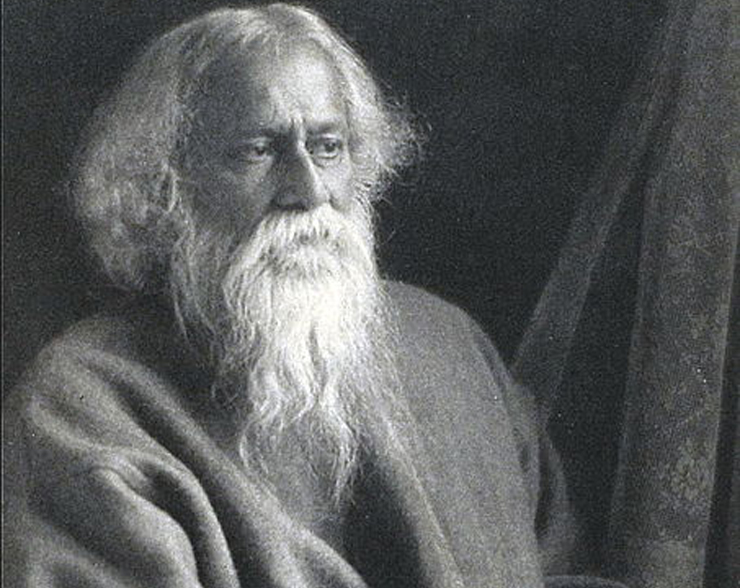 Rapprochement of Cultures.
Rapprochement of Cultures.
Rabindranath Tagore: The Call of the Universal Real.
Unknown authorUnknown author, Public domain, via Wikimedia Commons.
The same stream of life that runs through my veins night and day runs through the world and dances in rhythmic measures. It is the same life that shoots in joy through the dust of the earth in numberless blades of grass and breaks into tumultuous waves of leaves and flowers. It is the same life that is rocked in the ocean-cradle of birth and death, in ebb and in flow. I feel my limbs are made glorious by the touch of this world of life. And my pride from the life- throb of ages dancing in my blood this moment.
May 7 marks the anniversary of the birth of the Bengal and world poet Rabindranath Tagore. As he wrote:
«I was born in 1861. It was a great period in our history of Bengal. Just about that time the currents of three movements had met in the life of our country.» One current was religious – the Brahmo Samaj – founded by Raja Rammohan Roy (1774-1833) in which his family was active. Brahmo Samaj’s humanistic aim was to reopen the channel of spiritual life which, for Tagore, had been obstructed for many years by the sands and the debris of creeds, caste and external practices…Each great movement of thought and endeavour in any part of the world may have something unique in its expression, but the truth underlying any of them never has the meretricious cheapness of utter novelty about it. The great Ganges must not hesitate to declare its essential similarity to the Nile of Egypt or to the Yangtse-Kiang of China.»
An Innovative School «Santiniketan».
The second current was literary. It was an effort by Tagore and other poets and writers such as Bankim Chandra Chatterji (1838-1894) to awaken the Bengali language from its stereotyped style and limitations of language. His was an effort to bring the ordinary speech of Bengal into poetic form. He had had intimate contact with village life in Bengal early in his youth as his family had estates with many villages. Later in 1922 he created a center for rural development and reform «Sriniketan» along side an innovative school «Santiniketan» started in 1901 where he hoped that young and the old, the teacher and the student, would sit at the same table to take their daily food and the food of their eternal life.
Tagore was interested in all the religious currents in Bengal, devotional Hinduism and the popular and mystic currents of Islam as expressed by the Bauls whose poetry he transformed into songs. He wrote over 2000 songs; every change of season, each aspect of Bengal landscape, every sorrow and joy found a place in his songs which became Bengali folk music.
The third current was national. As Tagore wrote:
«The national was not fully political, but it began to give voice to the mind of the people, trying to assert their own personality. It was a voice of indignation at the humiliation constantly heaped upon us by people.» Tagore was the first to make popular the term «Mahatma» for Gandhi. «So disintegrated and demoralized were our people that many wondered if India could ever rise again by the genius of her own people, until there came on the scene a truly great soul, a great leader of men, in line with the tradition of the greatest sages of old Mahatma Gandhi. Today no one need despair of the future of the country, for the unconquerable spirit that creates has already been released. Mahatma Gandhi has shown us a way which, if we follow, shall not only save ourselves but may also help other peoples to save themselves.»
The call of the universal real.
Rabindranath Tagore was the Renaissance man of modern India – the bridge from an Indian culture dominated on the one hand by a traditionalism that had long ceased to be creative and on the other by English colonial practice whose reforms were self-interested. He was known world wide as a poet having received the Nobel Prize for Literature in 1913, especially for his set of poems Gitanjali championed by William Butler Yeats. Tagore’s aim was to combine a renewal of local thought, in particular that of his native Bengal with an appreciation of the cultures of the world.
As Tagore emphasized, the creative impulse was rooted in man’s desire to enhance the experiences of life. Man shared with the Divine Spirit the possibility of shaping the material world as well as his own personality according to the implicit laws of being. An artist responds to what Tagore named the call of the universal real through reverence, understanding and delight. An artist is aroused not by knowledge or emotion alone, but by the wholeness of his perceptions. The Real is that order which lies behind multiplicity.
«To be able to love material things, to clothe them with tender grace, and yet not to be attached to them, this is a great service.The wonder is not that there should be obstacles and sufferings in this world, but that there should be law and order, beauty and joy, goodness and love».
Rene Wadlow, President, Association of World Citizens.

Presidente, Asociación de World Citizens (AWC).
Cursó Estudios de Relaciones Internacionales en La Universidad de Chicago.
Cursó Estudios en el Programa Especial de Civilización Europea en
La Universidad de Princeton
Here are other publications that may be of interest to you.
Sorry, no posts were found.